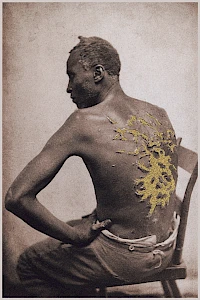Patterns
| Year: | 2021 |
| City: | Neuchâtel / Vienna |
| Measures: | 10 parts, each 22 x 22 x 3 cm 1 part, 32 x 42 x 4 cm |
| Media: | Goldwork on Fabric and Photo |
| Exhibitions: | |
| Catalogues: |
A wilderness of scars!
A field, by tangled furrows torn and riven!
A sea of waves, by meeting whirlwinds driven!
A cloud, storm-shattered through the midnight heaven!
A wreck of rayless stars! [1]
This photograph of a slave named "Gordon," was taken in Baton Rouge on April 2, 1863. He was whipped so cruelly that his entire back was a grim weave of wounds and scars. He fled from a 12 square mile cotton plantation on the Atchafalaya River. [2]
Printed fabrics called "Indiennes" had been popular in Europe since the 17th century. Such printed cotton was as pretty as silk and an alternative to linen and wool for the poorer classes.
The lucrative trade with them was connected with colonial exploitation and slave trade. For Switzerland, France's ban on the production and import of these cloths in the 17th century became a stroke of luck. French Protestants fleeing religious persecution to Switzerland established textile factories in Geneva and Neuchâtel, from where the Indiennes were smuggled across the border into France.
Demand peaked in those days: in 1785, the Fabrique-Neuve factory in Cortaillod, Neuchâtel, became the largest manufacturer of Indiennes in Europe.
Trade brought enormous prosperity to Switzerland, but at the expense of others: The trade in enslaved people was the basis of a triangular trade across the Atlantic. European merchants loaded their ships at Atlantic ports with rum, weapons, and especially with the Indiennes fabrics which were popular at African royal courts. In the ports of West Africa, they traded them for people who had been brought to the coast by African and Arab slave traders. The slaves were forcibly trafficked to the Americas and used there as unpaid workforce on the cotton plantations. The cotton was then brought back on ships to the textile mills of Switzerland and France for processing.
In 1830, there were around 21 Indienne factories in Geneva, Neuchâtel and Biel, employing nearly 3000 workers. Thanks to this strong cotton sector, the Swiss economy was able to hold its own during the Industrial Revolution, and Swiss companies that became big at that time later shaped Swiss development and culture.
[1] Rev. George Lansing Taylor: The Scourged Back. In: National Anti-Slavery Standard, 26. September 1863, p. 4, columne 1, auf: scolarlyediting.org.
[2] https://en.wikipedia.org/wiki/Gordon_(slave)











